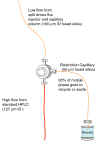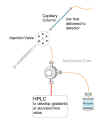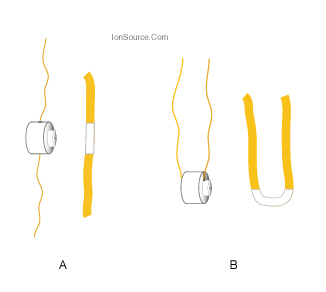| Return to IonSource Homepage | |||
|
Capillary HPLC UV Detection
|
|||
|
|
Click on the thumb nails in this column for a larger view | ||
|
Typical capillary HPLC flow rates present a special challenge for UV peak detection. Standard HPLCs have UV flow cells with internal volumes ranging from 8 to 12 µLs. The large volume of the standard flow cell makes it unsuitable for flow rates below 100 µL/min. A 12 µL volume represents roughly 2 minutes of volume at a typical capillary flow rate, so capillary HPLC peaks separated chromatographically by 2 min. are unresolved in the standard flow cell. In addition UV detectors are concentration dependent detectors and therefore the gains made in peak concentration by the capillary column would be negated by the dilution effect in the larger flow cell. |
 Figure 1 |
||
|
|
 Figure 2 |
||
 Figure 3 |
|||
|
Figure 4: A is a depiction of the on-column cell. The on-column cell is typically constructed from fused silica. A section of the polyimide coating is removed to create a UV transparent window. The on-column cell suffers from an extremely short path length which is essentially the ID of the FSC tubing. B depicts a cell in which the fused silica is bent in either a U or Z shape to increase the path length of the cell. |
|||
|
Capillary flow cells have traditionally been made by etching a UV transparent window in fused silica tubing, see Figure 4. Needless to say, Beer's law applies to capillary flow cells. The sensitivity of the flow cell will be determined by the path length and it's optical characteristics. There have basically been two ways to create a capillary flow cell from fused silica. Early capillary flow cells were made by etching a window in the fused silica capillary and placing the window between the light source and the detector. While this cell design is simple it lacks a significant path length. The path length in this cell is essentially the diameter of the fused silica tubing (typically 100 microns). This cell works and can be found on many capillary and CE systems. This simple cell, "on-column cell", has an ability to to detect analytes down to around 5 pmol when used in capillary HPLC. Manufacturers of capillary flow cells attempted to increase the sensitivity of the cell by increasing the path length. A cell was introduced in which a larger window was etched in the fused silica and the tubing was bent to create a longer cell path length (5 to 8 mm). This cell offers greater sensitivity with no increase in flow cell dead volume. The cell does suffer from poor optical characteristics because the light scatters as it traverses the cell. Due to the poor optical characteristics the response of this cell is generally not linear making it unsuitable for those tasks that require quantification. However, when the ultimate in sensitivity is required this cell works well. Detection down to 250 fmol can be routinely achieved with the U or Z shaped cell.
|
 Figure 4 |
||

|
|||
|
Figure 5: The figure above depicts the light lost through a bent fused silica flow cell. It is amazing that these cells work at all but they do and they work well. Some manufactures have installed ball lenses to help focus light through the tiny inlet hole. These bent cells reportedly suffer from non-linear response making them potentially unsuitable for quantification. |
|||
|
The difference in sensitivity between the on-column and U shaped cell is not phenomenal. The apparent non-linearity of the longer FSC cell design is due to the fact that while the U or Z shaped cell does have an increased path length it suffers from poor optical characteristics in comparison to the simpler on-column cell. The Z or U shaped cell with the increased path length can be readily purchased for most UV detectors. The Z or U shaped cell is more difficult to construct but is useful when exploring at very low levels. We choose to use this cell for proteome investigations or when collecting rare proteins for N-terminal sequence analysis. The on-column cell is easy to make and can be used for amounts above 5 pmol. Peaks tend to be sharper with the on-column cell, and linearity of response is achievable. |
|
||
|
. |
|||
|
TOC Introduction Glossary Simple System Automation UV Detection Plumbing The Truth About Splitting Applications Order Components References |

|
||
| - | |||
|
home
| disclaimer |
|||

